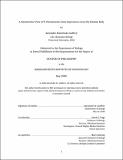| dc.contributor.advisor | David C. Page. | en_US |
| dc.contributor.author | Godfrey, Alexander Kamitsuka. | en_US |
| dc.contributor.other | Massachusetts Institute of Technology. Department of Biology. | en_US |
| dc.date.accessioned | 2020-09-03T17:48:30Z | |
| dc.date.available | 2020-09-03T17:48:30Z | |
| dc.date.copyright | 2020 | en_US |
| dc.date.issued | 2020 | en_US |
| dc.identifier.uri | https://hdl.handle.net/1721.1/127132 | |
| dc.description | Thesis: Ph. D., Massachusetts Institute of Technology, Department of Biology, May, 2020 | en_US |
| dc.description | Cataloged from the official PDF of thesis. | en_US |
| dc.description | Includes bibliographical references. | en_US |
| dc.description.abstract | Human Y-chromosome genes have long been known to play pivotal roles in two biological processes--sex determination and spermatogenesis. Recent studies have uncovered evidence that Y-chromosome genes also perform important functions beyond the reproductive tract. Little is known about the roles of Y-chromosome genes in these contexts, or how their expression might directly lead to differences between XX (female) and XY (male) individuals. This thesis presents a quantitative analysis of human Y-chromosome gene expression across 36 adult tissues collected from hundreds of individuals. Compared to past efforts, this work greatly expands the number of tissues in which Y-chromosome gene expression has been measured and offers a richly quantitative picture that could not previously be achieved. In contrast to traditional views of the Y chromosome, we show that Y-chromosome genes are abundantly expressed in a variety of tissues outside the reproductive tract. We additionally find that regulatory-sequence differences between the X and Y chromosomes can lead to Y-chromosome-driven, male-biased expression of critical regulatory genes. In one notable example, evolutionary loss of a conserved microRNA site on the Y chromosome enabled a Y-linked copy of eukaryotic initiation factor 1A, EIF1AY, but not its X-linked homolog EIF1AX, to be highly expressed in the heart. As a result, this essential translation initiation factor is nearly twice as abundant in male as in female heart tissue at the protein level. We were able to arrive at these conclusions through careful application of analytic and experimental methods suited specifically to the Y chromosome's complexity; guidelines for the selection and use of these methods are discussed. Taken as a whole, these efforts shed new light on the Y chromosome's evolution and possible roles in sex differences and suggest promising future avenues for Y-chromosome research. | en_US |
| dc.description.statementofresponsibility | by Alexander Kamitsuka Godfrey. | en_US |
| dc.format.extent | 169 pages | en_US |
| dc.language.iso | eng | en_US |
| dc.publisher | Massachusetts Institute of Technology | en_US |
| dc.rights | MIT theses may be protected by copyright. Please reuse MIT thesis content according to the MIT Libraries Permissions Policy, which is available through the URL provided. | en_US |
| dc.rights.uri | http://dspace.mit.edu/handle/1721.1/7582 | en_US |
| dc.subject | Biology. | en_US |
| dc.title | A quantitative view of Y-chromosome gene expression across the human body | en_US |
| dc.type | Thesis | en_US |
| dc.description.degree | Ph. D. | en_US |
| dc.contributor.department | Massachusetts Institute of Technology. Department of Biology | en_US |
| dc.identifier.oclc | 1191837377 | en_US |
| dc.description.collection | Ph.D. Massachusetts Institute of Technology, Department of Biology | en_US |
| dspace.imported | 2020-09-03T17:48:29Z | en_US |
| mit.thesis.degree | Doctoral | en_US |
| mit.thesis.department | Bio | en_US |
